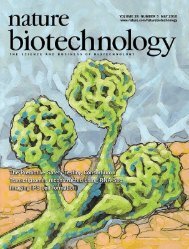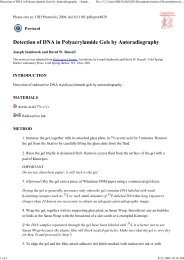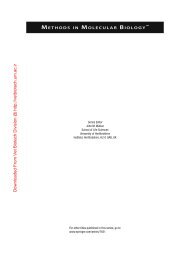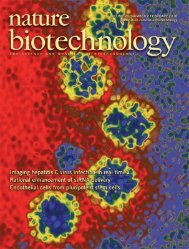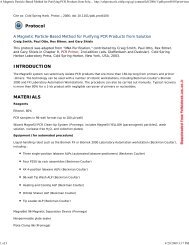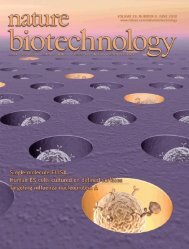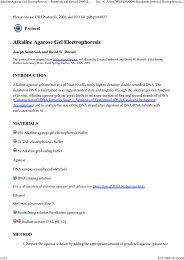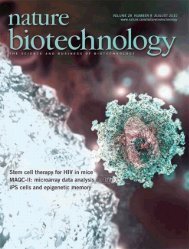The Unfolded Protein Response: From Stress Pathway
The Unfolded Protein Response: From Stress Pathway
The Unfolded Protein Response: From Stress Pathway
You also want an ePaper? Increase the reach of your titles
YUMPU automatically turns print PDFs into web optimized ePapers that Google loves.
<strong>The</strong> <strong>Unfolded</strong> <strong>Protein</strong> <strong>Response</strong>: <strong>From</strong> <strong>Stress</strong> <strong>Pathway</strong> to<br />
Homeostatic Regulation<br />
Peter Walter, et al.<br />
Science 334, 1081 (2011);<br />
DOI: 10.1126/science.1209038<br />
This copy is for your personal, non-commercial use only.<br />
If you wish to distribute this article to others, you can order high-quality copies for your<br />
colleagues, clients, or customers by clicking here.<br />
Permission to republish or repurpose articles or portions of articles can be obtained by<br />
following the guidelines here.<br />
<strong>The</strong> following resources related to this article are available online at<br />
www.sciencemag.org (this infomation is current as of November 28, 2011 ):<br />
Updated information and services, including high-resolution figures, can be found in the online<br />
version of this article at:<br />
http://www.sciencemag.org/content/334/6059/1081.full.html<br />
This article cites 49 articles, 28 of which can be accessed free:<br />
http://www.sciencemag.org/content/334/6059/1081.full.html#ref-list-1<br />
This article appears in the following subject collections:<br />
Cell Biology<br />
http://www.sciencemag.org/cgi/collection/cell_biol<br />
Downloaded from www.sciencemag.org on November 28, 2011<br />
Science (print ISSN 0036-8075; online ISSN 1095-9203) is published weekly, except the last week in December, by the<br />
American Association for the Advancement of Science, 1200 New York Avenue NW, Washington, DC 20005. Copyright<br />
2011 by the American Association for the Advancement of Science; all rights reserved. <strong>The</strong> title Science is a<br />
registered trademark of AAAS.
REVIEWS<br />
<strong>The</strong> <strong>Unfolded</strong> <strong>Protein</strong> <strong>Response</strong>:<br />
<strong>From</strong> <strong>Stress</strong> <strong>Pathway</strong> to<br />
Homeostatic Regulation<br />
Peter Walter 1 and David Ron 2<br />
<strong>The</strong> vast majority of proteins that a cell secretes or displays on its surface first enter the<br />
endoplasmic reticulum (ER), where they fold and assemble. Only properly assembled proteins<br />
advance from the ER to the cell surface. To ascertain fidelity in protein folding, cells regulate<br />
the protein-folding capacity in the ER according to need. <strong>The</strong> ER responds to the burden of<br />
unfolded proteins in its lumen (ER stress) by activating intracellular signal transduction pathways,<br />
collectively termed the unfolded protein response (UPR). Together, at least three mechanistically<br />
distinct branches of the UPR regulate the expression of numerous genes that maintain<br />
homeostasis in the ER or induce apoptosis if ER stress remains unmitigated. Recent advances<br />
shed light on mechanistic complexities and on the role of the UPR in numerous diseases.<br />
Secreted and membrane proteins fold and<br />
mature in the lumen of the endoplasmic<br />
reticulum (ER) before they are delivered<br />
to other compartments in the endomembrane system,<br />
displayed on the cell surface, or released<br />
extracellularly. A collection of phylogenetically<br />
conserved signaling pathways, collectively termed<br />
the unfolded protein response (UPR), monitors<br />
conditions in the ER, sensing an insufficiency in<br />
the ER’s protein-folding capacity (and hence the<br />
threat of misfolding) and communicates this information<br />
regarding the status of the ER lumen<br />
to gene expression programs of eukaryotic cells<br />
[reviewed in (1)]. UPR activation increases ER<br />
abundance to match needs by mediating expansion<br />
of the ER membrane (2) and populating the<br />
expanded organelle space with newly synthesized<br />
protein-folding machinery. This long-term, largely<br />
transcriptional control is accompanied by mechanisms<br />
that transiently decrease the flux of protein<br />
entering the ER. As such, the UPR is a paradigm<br />
for countless other feedback loops that establish<br />
and maintain homeostasis.<br />
Progress in cell biology is most beautifully<br />
revealed when complex cellular events become<br />
understood at the level of the molecular machines<br />
that orchestrate them. <strong>The</strong> UPR is one of these<br />
examples, where detailed molecular description<br />
has begun to elucidate how a eukaryotic cell regulates<br />
the abundance of its ER. <strong>The</strong> explosion<br />
of mechanistic knowledge has opened doors into<br />
entirely unanticipated discoveries concerning how<br />
the UPR is intricately integrated with other aspects<br />
of cell physiology to sustain homeostatic<br />
balance [reviewed in (3)].<br />
1 Howard Hughes Medical Institute and Department of Biochemistry<br />
and Biophysics, University of California, San Francisco,<br />
CA 94158, USA. E-mail: peter@walterlab.ucsf.edu 2 University of<br />
Cambridge, Metabolic Research Laboratory and NIHR Cambridge<br />
Biomedical Research Centre, Addenbrooke’s Hospital, Cambridge<br />
CB2 0QQ, UK. E-mail: dr360@medschl.cam.ac.uk<br />
Homeostasis<br />
ATF6 PERK IRE1<br />
Transcriptional<br />
response<br />
Increase in ER<br />
protein folding<br />
capacity<br />
ER stress<br />
Apoptosis<br />
Translational control<br />
mRNA decay<br />
Decrease in ER<br />
protein folding<br />
load<br />
Fig. 1. A simplified wiring diagram of the core elements of the<br />
UPR signaling network. ER stress activates the stress sensors<br />
ATF6, IRE1, and PERK, representing the three branches of the<br />
UPR. Activation of each sensor produces a transcription factor<br />
[ATF6(N), XBP1, and ATF4, respectively] that activates genes to<br />
increase the protein-folding capacity in the ER. IRE1 (via RIDD)<br />
and PERK (via eIF2a phosphorylation) also decrease the load of<br />
proteins entering the ER. Both outcomes work as feedback loops<br />
that mitigate ER stress. If cells cannot reestablish homeostasis but<br />
continue to experience prolonged and unmitigated ER stress<br />
(depicted by the timer), they apoptose.<br />
Virtually all signaling proteins that a eukaryotic<br />
cell uses to communicate with its environment<br />
are assembled in the ER. <strong>The</strong>y transmit and<br />
receive information crucial to the health of the<br />
organism, such as informing cells when to divide,<br />
migrate, differentiate, or die. Checkpoints to ensure<br />
that these components are assembled with<br />
high fidelity are to be expected; without such<br />
quality control, chaos would ensue. One of the<br />
primary functions of the ER is to exert such<br />
quality control on the proteins it makes: Only<br />
properly folded proteins are packaged into ER<br />
exit vesicles and allowed to move onward to be<br />
displayed on the cell surface (4, 5). Improperly<br />
folded proteins are retained in the ER and delivered<br />
for proteasomal degradation after retrotranslocation<br />
into the cytosol, a process called<br />
ER-associated degradation (ERAD) (6). ERAD<br />
is essential in cells that cannot induce the UPR<br />
(7), hinting at the importance of continual removal<br />
of polypeptides that fail to reach their<br />
native state.<br />
Prolonged activity of the UPR, an indication<br />
that ER stress cannot be mitigated and homeostasis<br />
cannot be reestablished, correlates<br />
with cell death [reviewed in (8)]. This suggests<br />
that the commitment to apoptosis in this context<br />
may have evolved to protect the<br />
organism from rogue cells that lack<br />
the capacity to ascertain the fidelity<br />
of their signaling components. A<br />
life-or-death decision, based on an<br />
assessment of whether ER stress can<br />
bemitigatedinatimelyfashion,nicely<br />
explains the UPR’s central role in<br />
numerous human diseases. When<br />
homeostasis fails, the UPR can<br />
serve as an apoptotic executor that<br />
kills cells that would be beneficial,<br />
or as a cytoprotector that safeguards<br />
rogue cells to the detriment<br />
of the organism. Examples in the first<br />
category include protein-misfolding<br />
diseases such as retinitis pigmentosa,<br />
an inherited form of blindness<br />
in which the retina degenerates by<br />
apoptotic cell death when a misfolded<br />
mutant rhodopsin is produced during<br />
retinal development (9). Another<br />
such example is type II diabetes, in<br />
which pancreatic beta cells are<br />
compromised by excessive demand<br />
for insulin production (10). <strong>The</strong> second<br />
category is exemplified by enveloped<br />
virus infections that can<br />
exploit the UPR to increase the<br />
capacity of the ER to assist in viral<br />
replication (11). Similarly, certain<br />
types of cancer—especially those<br />
that arise in secretory tissues, such<br />
as multiple myeloma—use the cytoprotective<br />
role of the UPR to sustain<br />
their rapid growth (12, 13).<br />
Given the dichotomy in outcomes<br />
of UPR activation, it remains unclear whether a<br />
window exists in which manipulation of the<br />
UPR can be harnessed therapeutically. Thus, it<br />
is important to develop a precise understanding<br />
of the molecular mechanism of signal trans-<br />
Downloaded from www.sciencemag.org on November 28, 2011<br />
www.sciencemag.org SCIENCE VOL 334 25 NOVEMBER 2011 1081
REVIEWS<br />
A ATF6<br />
B PERK<br />
C<br />
<strong>Unfolded</strong><br />
proteins<br />
<strong>Unfolded</strong> proteins<br />
ER lumen<br />
<strong>Unfolded</strong><br />
proteins<br />
IRE1<br />
Translocon<br />
Cleavage<br />
Vesicular<br />
transport<br />
to Golgi<br />
ATF6(N)<br />
Cytosol<br />
Golgi<br />
S1P<br />
S2P<br />
Proteolysis<br />
UPR<br />
target genes<br />
duction in the UPR and to develop compounds<br />
that can selectively modulate discrete steps of the<br />
pathway.<br />
<strong>The</strong> Three UPR Signal Transducers<br />
Three principal branches of the UPR have been<br />
identified (1) (Fig. 1). <strong>The</strong> branches operate in<br />
parallel and use unique mechanisms of signal<br />
transduction. Each branch is defined by a class of<br />
transmembrane ER-resident signaling components:<br />
IRE1 (inositol requiring enzyme 1), PERK<br />
[double-stranded RNA-activated protein kinase<br />
(PKR)–like ER kinase], and ATF6 (activating<br />
transcription factor 6). <strong>The</strong> IRE1 branch is the<br />
most conserved and sole branch of the UPR in<br />
lower eukaryotes (14). Evolution later added the<br />
PERK and ATF6 branches to metazoan cells. <strong>The</strong><br />
UPR branches are differently represented in different<br />
cell types; moreover, there are multiple<br />
genes encoding ATF6 family members and two<br />
IRE1 paralogs in mammalian cells, hinting at<br />
tissue and cell type specialization of the UPR that<br />
remains poorly understood. Activation of each<br />
eIF2<br />
eIF2<br />
ATF4<br />
GADD34<br />
XBP1 Chaperones<br />
Antioxidant response<br />
CHOP<br />
eIF2<br />
P<br />
Fig. 2. (A to C) <strong>The</strong> three branches of the UPR. Three families of signal transducers<br />
(ATF6, PERK, and IRE1) sense the protein-folding conditions in the ER<br />
lumen and transmit that information, resulting in production of bZIP transcription<br />
regulators that enter the nucleus to drive transcription of UPR target genes.<br />
Each pathway uses a different mechanism of signal transduction: ATF6 by<br />
P<br />
P<br />
P<br />
P<br />
Reduced ER<br />
protein folding<br />
load<br />
GADD34<br />
Redox enzymes<br />
Cell death<br />
IRE1<br />
mRNA<br />
processing<br />
XBP1 mRNA<br />
P<br />
XBP1s<br />
P<br />
P<br />
Ligation<br />
Translation<br />
Chaperones<br />
Lipid synthesis<br />
ERAD proteins<br />
mRNA<br />
decay<br />
Reduced ER<br />
protein folding<br />
load<br />
regulated proteolysis, PERK by translational control, and IRE1 by nonconventional<br />
mRNA splicing. In addition to the transcriptional responses that largely<br />
serve to increase the protein-folding capacity in the ER, both PERK and IRE1<br />
reduce the ER folding load by down-tuning translation and degrading ERbound<br />
mRNAs, respectively.<br />
branch leads to the production of b-ZIP transcription<br />
factors, which work alone or together<br />
to activate UPR target genes.<br />
ATF6 is a transcription factor that is initially<br />
synthesized as an ER-resident transmembrane protein<br />
bearing a large ER-luminal domain (Fig. 2A).<br />
Upon accumulation of unfolded proteins, it is<br />
packaged into transport vesicles that pinch off the<br />
ER and deliver it to the Golgi apparatus (15).<br />
<strong>The</strong>re, it encounters two proteases, S1P and S2P<br />
(site-1 and site-2 protease), that sequentially remove<br />
the luminal domain and the transmembrane<br />
anchor, respectively (16, 17). <strong>The</strong> liberated<br />
N-terminal cytosolic fragment, ATF6(N), then<br />
moves into the nucleus to activate UPR target<br />
genes. Among ATF6’s targets are prominent<br />
ER-resident proteins involved in protein folding,<br />
such as BiP (a chaperone of the heat shock protein<br />
HSP70 family), protein disulfide isomerase,<br />
and glucose-regulated protein 94 (GRP94; a chaperone<br />
of the Hsp90 family). ATF6 processing resembles<br />
the mechanism by which sterol response<br />
element binding protein (SREBP), the transcription<br />
factor that controls sterol biosynthesis, is regulated<br />
in mammalian cells and uses the same<br />
proteases (18). Whereas the mechanism of SREBP<br />
control at the level of ER exit is well understood,<br />
little is known about how ATF6 responds to ER<br />
stress. Its ER-luminal domain shows no sequence<br />
homology to other proteins. ATF6 associates with<br />
BiP, and BiP release under conditions of ER stress<br />
may contribute to its activation. <strong>The</strong> ATF6 luminal<br />
domain also contains intra- and intermolecular<br />
disulfide bonds that may monitor the ER environment<br />
as redox sensors.<br />
<strong>The</strong> second branch of the UPR is mediated<br />
by PERK, an ER-resident transmembrane kinase<br />
(Fig. 2B). When activated upon sensing ER<br />
stress, PERK oligomerizes and phosphorylates<br />
itself and the ubiquitous translation initiation factor<br />
eIF2a, indirectly inactivating eIF2 and inhibiting<br />
mRNA translation. In this way, PERK helps<br />
reduce the flux of protein entering the ER to<br />
alleviate ER stress. However, some mRNAs containing<br />
short open reading frames in their 5′-<br />
untranslated regions are preferentially translated<br />
P<br />
Downloaded from www.sciencemag.org on November 28, 2011<br />
1082<br />
25 NOVEMBER 2011 VOL 334 SCIENCE www.sciencemag.org
REVIEWS<br />
when eIF2 is limiting. One of these encodes the<br />
transcription factor ATF4, whose translation is<br />
thus induced. Two important target genes driven<br />
by ATF4 are CHOP (transcription factor C/EBP<br />
homologous protein) and GADD34 (growth arrest<br />
and DNA damage–inducible 34). CHOP is a<br />
transcription factor that controls genes encoding<br />
components involved in apoptosis. Thus, the<br />
PERK branch of the UPR is strongly protective<br />
at modest levels of signaling but can contribute<br />
signals to cell death pathways. This dualism is<br />
likely played out at the level of phosphorylated<br />
eIF2a and is exemplified by the effects of manipulation<br />
of its specific phosphatases. GADD34<br />
encodes a PERK-inducible regulatory subunit of<br />
the protein phosphatase PP1C that counteracts<br />
PERK by dephosphorylating eIF2a. Selective<br />
inhibition of the GADD34-PP1c complex, either<br />
by a small molecule or deletion of GADD34,<br />
protects cells against ER stress by prolonging lowlevel<br />
eIF2a phosphorylation (19, 20). <strong>The</strong> importance<br />
of such balanced regulation of eIF2a<br />
dephosphorylation is emphasized by the lethal consequences<br />
of deletion of the constitutive eIF2a<br />
phosphatase, CReP, when GADD34 is compromised<br />
(20, 21).<br />
IRE1 defines the third and, because of its<br />
presence in yeast, best-studied branch of the<br />
UPR (Fig. 2C). It is a bifunctional transmembrane<br />
kinase/endoribonuclease that uses a unique mechanism<br />
of nonconventional mRNA splicing to<br />
transmit the UPR signal. Its ribonuclease (RNase)<br />
function is activated by conformational changes<br />
following lateral IRE1 oligomerization in the<br />
ER membrane. When activated, IRE1 cleaves<br />
the mRNA encoding a UPR-specific transcription<br />
factor, called XBP1 (X-box binding protein<br />
1) in metazoans, in two specific positions,<br />
excising an intron. <strong>The</strong> severed exons are then<br />
ligated (by tRNA ligase in yeast and by one or<br />
more yet-undiscovered enzymes in mammalian<br />
cells), giving rise to a spliced mRNA that is<br />
translated to the active forms of the transcription<br />
factor XBP1 s (the superscript indicates that it is<br />
the product of the spliced mRNA). In yeast, IRE1<br />
activity drives the entire UPR gene expression<br />
program, whereas in metazoans there appears to<br />
be considerable redundancy between UPR-induced<br />
transcription factors. Nonetheless, XBP1 s appears<br />
to have a special role in regulating lipid<br />
biosynthetic enzymes and ER-associated degradation<br />
components, as well as in promoting the<br />
development of an elaborate ER that is characteristic<br />
of active secretory cells (22).<br />
Molecular Insight into IRE1 Activation<br />
Structural and biophysical experiments have provided<br />
a detailed view of IRE1 activation. RNase<br />
activation proceeds from inactive monomers that<br />
assemble into back-to-back dimers (23), which<br />
further stack into higher-order oligomers (24).<br />
During activation, IRE1 autophosphorylates, perhaps<br />
in a front-to-front interaction between IRE1<br />
monomers; such a conformation would favor the<br />
activating trans-autophosphorylation event but<br />
A<br />
B<br />
ER lumen<br />
C<br />
D<br />
IRE1 luminal domain<br />
Cytosol<br />
IRE1<br />
IRE1 kinase/RNase domains<br />
Yeast IRE1-GFP<br />
<strong>Unfolded</strong><br />
protein<br />
ATP<br />
1 2<br />
3 4<br />
RNase active ?<br />
Mammal IRE1-GFP<br />
RNase active<br />
Uninduced UPR-induced Uninduced UPR-induced<br />
Fig. 3. A speculative model of IRE1 activation. <strong>The</strong> figure depicts multiple structures of the IRE1<br />
luminal ER stress–sensing domain (A) and the IRE1 cytosolic kinase and RNase domains (C), aligned<br />
in a hypothetical sequence (B) by which IRE1 may be activated in response to an accumulation of<br />
unfolded proteins in the ER lumen. IRE1 protomers (step 1) engage homotypically in the plane of the<br />
membrane. ER luminal domains may form a closed dimer in which the proposed peptide-binding<br />
groove is occluded and further oligomerization is prevented (40). In response to protein misfolding<br />
(step 2), the luminal domain rearranges, allowing unfoldedproteinbinding(proposed peptide-binding<br />
groove outlined in red) and further oligomerization (38), leading to front-to-front interactions of the<br />
kinase/RNase domains on the other, cytosolic side of the ER membrane. Such interactions are observed<br />
in crystals on the nonphosphorylated human IRE1 and may correspond to a pre-autophosphorylation<br />
complex (25). After trans-autophosphorylation, IRE1 forms back-to-back dimers (step 3) (24) thatstack<br />
into oligomers (step 4) (23). <strong>The</strong> crystallized IRE1 kinase domains (shown in gold) contain either a bound<br />
adenosine diphosphate–Mg complex (23)orakinaseinhibitor(24) shown in green. <strong>The</strong> RNase active site<br />
is located in the cleft between two RNase monomers (shown in purple with the catalytic histidines in red)<br />
as arranged in the IRE1 back-to-back dimer and oligomer. PDB access numbers: 2HZ6 and 2BE1 for<br />
structures shown in (A); 3P23, 2RIO, and 3FBV for those shown in (C). (D) Clusters of activated, oligomeric<br />
IRE1 are visible by fluorescence microscopy as discrete foci in yeast (Saccharomyces cerevisiae) and<br />
mammalian (HEK293) cells.<br />
leave the dimeric RNase site unassembled (25).<br />
Trans-autophosphorylation may continue between<br />
stacked dimers in the IRE1 oligomer (24)(Fig.3).<br />
Phosphorylation of IRE1 on its activation loop,<br />
as with other protein kinases, enhances nucleotide<br />
binding to its kinase active site; however, the<br />
phosphorylation state of IRE1 is likely to modulate<br />
its activity in other ways as well. In the<br />
structure of the IRE1 oligomer, a small number<br />
of phosphates form stabilizing salt bridges to<br />
Downloaded from www.sciencemag.org on November 28, 2011<br />
www.sciencemag.org SCIENCE VOL 334 25 NOVEMBER 2011 1083
REVIEWS<br />
adjacent protomers, suggesting a role for phosphorylation<br />
in IRE1 activation (24). In contrast<br />
to PERK and all other protein kinases that conventionally<br />
propagate a signal via phosphoryltransfer<br />
reactions, the kinase activity of IRE1 can<br />
be entirely bypassed. In yeast, IRE1 mutants with<br />
inactivated kinase activity still oligomerize in response<br />
to an accumulation of unfolded protein in<br />
the ER and mediate the mRNA splicing reaction,<br />
albeit with slightly reduced activity. Surprisingly,<br />
such mutants are much delayed in turning off<br />
the splicing reaction after resolution of ER stress.<br />
Failure to properly inactivate IRE1 inappropriately<br />
prolongs UPR signaling and reduces cell<br />
survival under UPR-inducing conditions (26, 27).<br />
Thus, autophosphorylation is a critical feature of<br />
the UPR homeostatic feedback loop. Phosphates<br />
added early may help to stabilize IRE1 oligomers<br />
as they form and open up the active site to promote<br />
binding of further activating ligands. Phosphates<br />
added later may destabilize oligomers,<br />
perhaps simply by building up charge repulsion<br />
in the IRE1 oligomer or by providing binding<br />
sites for other factors that aid in oligomer disassembly.<br />
Such a mechanism might promote a dynamic<br />
equilibrium between phosphorylated IRE1<br />
embedded in the active oligomers and hyperphosphorylated<br />
IRE1 prone to dissociate from the active<br />
oligomers.<br />
<strong>The</strong>re is increasing evidence that the threshold<br />
concentration that triggers IRE1 activation<br />
can be modulated by various means. For example,<br />
small molecules that bind to IRE1’s kinase<br />
active site can be inhibitors or activators of various<br />
potencies (28). Binding of these compounds<br />
is thought to shift the equilibrium between two<br />
conformational states that are conserved among<br />
protein kinases: “aC-helix in” and “aC-helix<br />
out.” In the first of these conformations, IRE1 is<br />
prone to oligomerize and activate; in the second,<br />
it is inactive. <strong>The</strong> kinase domain of IRE1<br />
thus acts as a conformational module, and occupancy<br />
with ligands can modulate the activation<br />
threshold. This provides a means for IRE1 to be<br />
regulated by nucleotides (or perhaps other metabolites<br />
that engage its nucleotide-binding pocket).<br />
Yeast IRE1 has a second ligand binding site<br />
at the dimer interface through which oligomerization<br />
and activity can be modulated, so far only<br />
in vitro (29).<br />
IRE1’s Interaction with Substrates<br />
Recent work has drawn attention to the mechanisms<br />
that target the XBP1 mRNA substrate to<br />
IRE1. In budding yeast, the HAC1 mRNA (the<br />
yeast XBP1 ortholog) contains a targeting signal<br />
in its 3′-untranslated region that is required and<br />
sufficient to localize the mRNA to activated<br />
IRE1 (30). By contrast, mammalian XBP1 u ,the<br />
protein translated from unspliced XBP1 mRNA,<br />
contains an internal hydrophobic stretch in its<br />
C-terminal region that acts as a signal sequence<br />
to bring the XBP1 u -translating polyribosome<br />
to the ER membrane (31). In plants, the XBP1<br />
homolog bZIP60 is also translated from the unspliced<br />
mRNA and is targeted to the ER membrane<br />
as an integral membrane protein (32). In<br />
both cases, splicing shifts the open reading frame<br />
so that the hydrophobic targeting sequences are<br />
no longer translated, resulting in the production<br />
of the soluble transcription factors. Thus, intriguing<br />
parallels exist between bZIP60 and<br />
ATF6, where transcription factors are produced<br />
upon UPR induction from resident ER membrane<br />
proteins by mRNA splicing or proteolysis,<br />
respectively.<br />
<strong>The</strong> cytoplasmic kinase/RNase domain of<br />
yeast IRE1 displays strongly cooperative activation<br />
kinetics, indicating that more than two IRE1<br />
molecules must assemble to form a fully active<br />
enzyme (24). Oligomerization can be visualized<br />
in the light microscope by following fluorescently<br />
tagged IRE1 fusion proteins (Fig. 3D)<br />
(30, 33, 34), which upon UPR activation cluster<br />
dynamically into discrete foci in the ER membrane<br />
in close enough molecular proximity to<br />
allow fluorescent energy transfer between fluorophores<br />
(35). One model based on a crystal<br />
structure of the active, oligomeric form of IRE1<br />
poses that protein interfaces, which form when<br />
IRE1 dimers stack in an oligomeric assembly,<br />
stabilize the RNase active site, providing an intuitive<br />
view of how oligomerization and enzymatic<br />
activation may be coupled. Because of its<br />
cooperative nature, IRE1 RNase activates abruptly<br />
upon reaching a critical threshold concentration<br />
(24), which lends switch-like properties to<br />
IRE1’s cytosolic module. In the context of the<br />
cell, the signal of many IRE1 modules producing<br />
such binary output must be integrated to produce<br />
a graduated response that reflects the strength<br />
of the input signal and is useful for homeostatic<br />
control. Such integration could occur simply by<br />
summing up signals from multiple locations in<br />
the ER, in effect “counting” the number of active<br />
IRE1 clusters at any one time.<br />
<strong>Unfolded</strong> <strong>Protein</strong> Sensing and Alternative Modes<br />
of UPR Activation<br />
To sense unfolded proteins in the ER lumen,<br />
UPR signaling proteins must be subservient to<br />
Box 1. Major unsolved questions.<br />
their luminal sensor domains. However, all proteins<br />
enter the ER in an unfolded state. Thus,<br />
the activation thresholds of IRE1, PERK, and<br />
ATF6 must be properly tuned. Early work suggested<br />
that binding to BiP retains IRE1 and PERK<br />
in a monomeric, inactive state, and that competition<br />
by unfolded proteins for BiP favors its<br />
dissociation from the luminal domains, allowing<br />
spontaneous oligomerization of PERK and<br />
IRE1 (1). However, subsequent work in yeast<br />
showed that IRE1 mutants that no longer bind<br />
BiP in a measurably regulated manner activate<br />
their UPR efficiently (35, 36), indicating that<br />
IRE1 regulation can proceed independently of<br />
regulated BiP release. An alternative model suggests<br />
that IRE1 binds to unfolded proteins directly<br />
and that these serve as activating ligands.<br />
This direct binding model is supported by the<br />
crystal structure of the yeast IRE1 luminal domain,<br />
which reveals a major histocompatibility<br />
complex (MHC)–like architecture containing a<br />
groove poised for peptide binding (37). Recent<br />
evidence that IRE1 binds to unfolded proteins<br />
and that extended peptides trigger oligomerization<br />
of the IRE1 luminal domain provides further<br />
support for the idea that IRE1 directly senses unfolded<br />
proteins (38, 39). <strong>The</strong> mammalian IRE1<br />
luminal domain crystallizes in a different conformation<br />
with a closed binding groove (40),<br />
which suggests that conformational changes that<br />
stabilize the open conformation upon peptide<br />
binding may trigger oligomerization and thus<br />
lead to IRE1 activation (Fig. 3A). Rather than<br />
providing the switch that activates the UPR, the<br />
interaction of the IRE1 (and, by extension, PERK)<br />
luminal domain with BiP may serve a subtler role<br />
as a buffer for monomers, thereby stabilizing at<br />
an appropriate level the concentration of IRE1<br />
monomers available for activation by unfolded<br />
protein ligands (35).<br />
Although unfolded protein recognition is generally<br />
regarded as the primary mode of UPR activation,<br />
there is increasing evidence that the<br />
luminal domain does not always govern IRE1<br />
activation. Surprisingly, IRE1 in which the luminal<br />
domain is eliminated and replaced by a<br />
1. What is the basis for toxicity of unfolded or misfolded proteins in the ER?<br />
2. How can we define and experimentally measure unfolded protein burden in the ER? What<br />
fraction of ER chaperones is engaged with unfolded proteins?<br />
3. What is the ultrastructure of active IRE1 and PERK in the ER membrane? What other components<br />
arepartofthesesignalingplatforms?<br />
4. Are there effectors of the IRE1 kinase domain other than IRE1 itself?<br />
5. How is ATF6 activated?<br />
6. How can we rationalize the division of target genes among the three UPR branches? What was the<br />
evolutionary drive toward this specialization?<br />
7. Are RIDD- and PERK-mediated translational control spatially restricted?<br />
8. What mechanistic details distinguish IRE1-mediated mRNA splicing and RIDD?<br />
9. Is there a therapeutic window in which manipulation of the UPR can be beneficial in treating<br />
human disease?<br />
10. How do IRE1, PERK, and ATF6 sense membrane aberrancy?<br />
Downloaded from www.sciencemag.org on November 28, 2011<br />
1084<br />
25 NOVEMBER 2011 VOL 334 SCIENCE www.sciencemag.org
REVIEWS<br />
leucine zipper (thus rendering it a constitutive<br />
dimer) remains strongly inducible by changes in<br />
the lipid composition (41). It is possible that the<br />
artificial dimerization provides seeds that poise<br />
IRE1 for oligomerization upon perturbations in<br />
the membrane environment. Similarly, ATF6<br />
(but not IRE1) is selectively activated by overexpression<br />
of an ER tail-anchored protein that<br />
contains only a few amino acids in the ER lumen<br />
(42). <strong>The</strong> transcriptional profile resulting from<br />
this activation event is qualitatively distinct from<br />
that obtained upon UPR activation by unfolded<br />
proteins, which reinforces the notion that preferential<br />
activation of individual UPR branches modulates<br />
the response.<br />
Another instance in which IRE1 signaling may<br />
not rely on ER-luminal sensing of unfolded proteins<br />
is IRE1 activation during B cell differentiation<br />
into plasma cells. Because of the massive<br />
amount of immunoglobulins secreted by plasma<br />
cells, the ER becomes highly amplified, and hence<br />
XBP1 s expression is required for this developmental<br />
step (22). Unexpectedly, UPR induction<br />
precedes a measurable ramping-up of immunoglobulin<br />
expression, which suggests that IRE1<br />
activation in this case may be driven by a developmental<br />
switch rather than by overburdening<br />
the ER with a secretory load (43). Indeed, mutant<br />
B cells that make no immunoglobulin still induce<br />
IRE1 in response to differentiation signals (44).<br />
In this example, the UPR appears to act in an<br />
“anticipatory” mode, switched on by cellular cues<br />
that may not originate in the ER lumen, in contrast<br />
to the classical “reactive” mode that responds<br />
to conditions within the ER.<br />
Nontranscriptional Aspects of UPR Regulation<br />
IRE1-mediated splicing of XBP1 mRNA is extraordinarily<br />
specific. In budding yeast, the orthologous<br />
HAC1 mRNA stands out as the single<br />
identifiable IRE1 substrate, and no mRNAs other<br />
than XBP1 are known to be spliced in an IRE1-<br />
dependent way in metazoans. This highly specific<br />
mode of mRNA engagement with IRE1 is<br />
distinct from a parallel mode of RNA cleavage in<br />
which diverse mRNAs are degraded in an IRE1-<br />
dependent fashion (45). This pathway, called RIDD<br />
(“regulated IRE1-dependent decay”), degrades<br />
ER-bound mRNAs in metazoans and may serve<br />
to limit protein influx and unfolded protein load<br />
into the ER lumen after prolonged UPR induction<br />
(Fig. 2C). It is thought that mRNAs are first<br />
nicked by the IRE1 endonuclease at sites that, by<br />
contrast to the well-conserved splice junctions<br />
in XBP1 mRNA, do not display an identifiable<br />
consensus sequence, and hence may be relatively<br />
degenerate. <strong>The</strong> free ends thus generated are<br />
substrates for exonucleolytic decay by the cytosolic<br />
exosome. Weak activation of IRE1 attained<br />
by small molecules uncouples XBP1 mRNA splicing<br />
from RIDD, raising the question of how IRE1<br />
switches between specific and promiscuous modes<br />
of cleavage (46, 47). One possibility is that IRE1<br />
assumes a qualitatively different state, perhaps<br />
governed by its kinase domain and ligands bound<br />
to it. Alternatively, IRE1’s promiscuous mode<br />
may more simply reflect grades of RNase activity<br />
responsive to the strength and duration of<br />
underlying ER stress, perhaps mediated by the<br />
assembly of higher-order oligomers in which<br />
multiple RNA binding sites line up to promote<br />
avidity (24).<br />
Both RIDD and the translational inhibition<br />
that occurs in response to eIF2a phosphorylation<br />
by PERK have similar consequences in that they<br />
reduce the influx of proteins into the ER. Both<br />
mechanisms must be carefully controlled, because<br />
excessive activation is detrimental to cell<br />
survival. Reducing the load of proteins entering<br />
the ER must be balanced with the need to sustain<br />
sufficient synthesis of the protein-folding machinery<br />
itself and of all the other essential proteins<br />
that fold in the ER. Indeed, the similarities<br />
between RIDD and eIF2a phosphorylation may<br />
extend further if we consider that both events<br />
are poised to exert local control: RIDD targets<br />
mRNAs that are in proximity to activated clusters<br />
of IRE1, whereas phosphorylation presumably<br />
targets eIF2a molecules in proximity to activated<br />
PERK. We speculate that under normal<br />
cell growth conditions, subtle fluctuations in<br />
capacity and demand may be restricted to certain<br />
regions of the ER rather than affecting<br />
the entire organelle, and that localized activation<br />
of PERK and RIDD may allow spatially<br />
restricted fine-tuned homeostatic adjustments.<br />
This is in contrast to the global control by activation<br />
of transcriptional programs effected by<br />
the three UPR branches, which integrate signals<br />
across the cell. <strong>The</strong> altered gene expression<br />
resulting from their action in turn affects the cell<br />
as a whole.<br />
Consequences of Sustained ER <strong>Stress</strong><br />
Cell-wide integration of UPR signaling is particularly<br />
important when cells make the decision<br />
to commit to apoptosis. It is unclear whether a<br />
single or multiple alternative mechanisms result<br />
in ER stress–induced cell death. One attractive<br />
possibility is that the three UPR branches provide<br />
opposing signals and that the relative timing of<br />
their induction shifts the balance between cytoprotection<br />
and apoptosis as unmitigated ER stress<br />
persists. IRE1 signaling, for example, attenuates<br />
upon prolonged ER stress (48), and, likewise,<br />
PERK signaling induces its own deactivation via<br />
GADD34 expression. Both pathways thus contain<br />
intrinsic timers that are likely to contribute to<br />
the life-or-death decision. <strong>The</strong> complexity of regulation<br />
and our challenge of deciphering it are<br />
further increased because the very components<br />
of the UPR, including IRE1, XBP1, PERK, and<br />
ATF6, are themselves transcriptionally controlled<br />
by the UPR. Moreover, apoptosis is only one<br />
possible outcome of chronic ER stress. Studies<br />
in chondrocytes, which abundantly secrete collagens,<br />
have shown that dedifferentiation away<br />
from a secretory cell phenotype may play a role<br />
in adaptation to chronic ER stress (49). This suggests<br />
that the pathogenic features of chronic ER<br />
stress may be played out not only at the level<br />
of cell death but also at the level of altered cell<br />
function.<br />
Conclusions<br />
<strong>The</strong> role of the UPR is to protect cells against<br />
defects in protein folding in the ER. Because<br />
many mechanisms come into play, the cell carefully<br />
balances various means at its disposal to<br />
protect against proteotoxicity while also providing<br />
adequate protein synthesis to sustain fitness.<br />
Despite enormous progress in the field, many fundamental<br />
questions remain unanswered (Box 1).<br />
<strong>The</strong> potential impact of the UPR in many human<br />
diseases makes UPR signaling a promising target<br />
for therapeutic intervention.<br />
References and Notes<br />
1. D. Ron, P. Walter, Nat. Rev. Mol. Cell Biol. 8, 519<br />
(2007).<br />
2. S. Schuck, W. A. Prinz, K. S. Thorn, C. Voss, P. Walter,<br />
J. Cell Biol. 187, 525 (2009).<br />
3. D. T. Rutkowski, R. S. Hegde, J. Cell Biol. 189, 783<br />
(2010).<br />
4. S. M. Hurtley, D. G. Bole, H. Hoover-Litty, A. Helenius,<br />
C. S. Copeland, J. Cell Biol. 108, 2117 (1989).<br />
5. L. Ellgaard, A. Helenius, Nat. Rev. Mol. Cell Biol. 4, 181<br />
(2003).<br />
6. M. H. Smith, H. L. Ploegh, J. S. Weissman, Science 334,<br />
1086 (2011).<br />
7. K. J. Travers et al., Cell 101, 249 (2000).<br />
8. I. Tabas, D. Ron, Nat. Cell Biol. 13, 184 (2011).<br />
9. J. H. Lin, M. M. Lavail, Adv. Exp. Med. Biol. 664, 115<br />
(2010).<br />
10. S. G. Fonseca, J. Gromada, F. Urano, Trends Endocrinol.<br />
Metab. 22, 266 (2011).<br />
11. B. Li et al., Virus Res. 124, 44 (2007).<br />
12. D. R. Carrasco et al., Cancer Cell 11, 349 (2007).<br />
13. I. Papandreou et al., Blood 117, 1311 (2011).<br />
14. K. Mori, J. Biochem. 146, 743 (2009).<br />
15. A. J. Schindler, R. Schekman, Proc. Natl. Acad. Sci. U.S.A.<br />
106, 17775 (2009).<br />
16. K. Haze, H. Yoshida, H. Yanagi, T. Yura, K. Mori,<br />
Mol. Biol. Cell 10, 3787 (1999).<br />
17. J. Ye et al., Mol. Cell 6, 1355 (2000).<br />
18. M. S. Brown, J. L. Goldstein, Proc. Natl. Acad. Sci. U.S.A.<br />
96, 11041 (1999).<br />
19. S. J. Marciniak et al., Genes Dev. 18, 3066 (2004).<br />
20. P. Tsaytler, H. P. Harding, D. Ron, A. Bertolotti, Science<br />
332, 91 (2011).<br />
21. H. P. Harding et al., Proc. Natl. Acad. Sci. U.S.A. 106,<br />
1832 (2009).<br />
22. A. M. Reimold et al., Nature 412, 300 (2001).<br />
23. K. P. Lee et al., Cell 132, 89 (2008).<br />
24. A. V. Korennykh et al., Nature 457, 687 (2009).<br />
25. M. M. Ali et al., EMBO J. 30, 894 (2011).<br />
26. A. Chawla, S. Chakrabarti, G. Ghosh, M. Niwa, J. Cell Biol.<br />
193, 41 (2011).<br />
27. C. Rubio et al., J. Cell Biol. 193, 171 (2011).<br />
28. A. V. Korennykh et al., BMC Biol. 9, 48 (2011).<br />
29. R. L. Wiseman et al., Mol. Cell 38, 291 (2010).<br />
30. T. Aragón et al., Nature 457, 736 (2009).<br />
31. K. Yanagitani, Y. Kimata, H. Kadokura, K. Kohno, Science<br />
331, 586 (2011); 10.1126/science.1197142.<br />
32. Y. Deng et al., Proc. Natl. Acad. Sci. U.S.A. 108, 7247<br />
(2011).<br />
33. Y. Kimata et al., J. Cell Biol. 179, 75 (2007).<br />
34. H. Li, A. V. Korennykh, S. L. Behrman, P. Walter,<br />
Proc. Natl. Acad. Sci. U.S.A. 107, 16113 (2010).<br />
35. D. Pincus et al., PLoS Biol. 8, e1000415 (2010).<br />
36. Y. Kimata, D. Oikawa, Y. Shimizu, Y. Ishiwata-Kimata,<br />
K. Kohno, J. Cell Biol. 167, 445 (2004).<br />
37. J. J. Credle, J. S. Finer-Moore, F. R. Papa, R. M. Stroud,<br />
P. Walter, Proc. Natl. Acad. Sci. U.S.A. 102, 18773<br />
(2005).<br />
Downloaded from www.sciencemag.org on November 28, 2011<br />
www.sciencemag.org SCIENCE VOL 334 25 NOVEMBER 2011 1085
REVIEWS<br />
38. B. M. Gardner, P. Walter, Science 333, 1891 (2011);<br />
10.1126/science.1209126.<br />
39. S. Kawaguchi, D. T. W. Ng, Science 333, 1830<br />
(2011).<br />
40. J. Zhou et al., Proc. Natl. Acad. Sci. U.S.A. 103, 14343<br />
(2006).<br />
41. T. Promlek et al., Mol. Biol. Cell 22, 3520 (2011).<br />
42. J. Maiuolo, S. Bulotta, C. Verderio, R. Benfante,<br />
N. Borgese, Proc. Natl. Acad. Sci. U.S.A. 108, 7832<br />
(2011).<br />
43. E. van Anken et al., Immunity 18, 243 (2003).<br />
44. C. C. Hu, S. K. Dougan, A. M. McGehee, J. C. Love,<br />
H. L. Ploegh, EMBO J. 28, 1624 (2009).<br />
45. J. Hollien, J. S. Weissman, Science 313, 104 (2006).<br />
46. J. Hollien et al., J. Cell Biol. 186, 323 (2009).<br />
47. D. Han et al., Cell 138, 562 (2009).<br />
48. J. H. Lin et al., Science 318, 944 (2007).<br />
49. K. Y. Tsang et al., PLoS Biol. 5, e44 (2007).<br />
Acknowledgments: We thank A. Korrenykh, A. Göke, and<br />
members of the Walter lab for helpful comments on the<br />
manuscript; K. Gotthardt for help in preparing the<br />
structural models; and D. Pincus and H. Li for<br />
contributing the fluorescence micrographs in Fig. 3.<br />
Supported by funds from the Howard Hughes Medical<br />
Institute and the Wellcome Trust. P.W. is an Investigator<br />
of the Howard Hughes Medical Institute and D.R. is a<br />
Principal Research Fellow of the Wellcome Trust.<br />
10.1126/science.1209038<br />
Road to Ruin: Targeting <strong>Protein</strong>s<br />
for Degradation in the<br />
Endoplasmic Reticulum<br />
Melanie H. Smith, 1 Hidde L. Ploegh, 2 Jonathan S. Weissman 1 *<br />
Some nascent proteins that fold within the endoplasmic reticulum (ER) never reach their<br />
native state. Misfolded proteins are removed from the folding machinery, dislocated from the<br />
ER into the cytosol, and degraded in a series of pathways collectively referred to as ER-associated<br />
degradation (ERAD). Distinct ERAD pathways centered on different E3 ubiquitin ligases survey<br />
the range of potential substrates. We now know many of the components of the ERAD<br />
machinery and pathways used to detect substrates and target them for degradation. Much less<br />
is known about the features used to identify terminally misfolded conformations and the broader<br />
role of these pathways in regulating protein half-lives.<br />
<strong>Protein</strong>s destined for secretion or insertion<br />
into the membrane enter the endoplasmic<br />
reticulum (ER) in an unfolded form and<br />
generally leave only after they have reached their<br />
native states. Yet, folding in the ER is often slow<br />
and inefficient, with a substantial fraction of polypeptides<br />
failing to reach the native state. Thus,<br />
the cell must continuously assess the pool of folding<br />
proteins and remove polypeptides that are<br />
terminally misfolded. This process of culling is<br />
critical to protect the cell from the toxic effects of<br />
misfolded proteins.<br />
Remarkably, many proteins triaged as terminally<br />
misfolded are first removed from the<br />
ER via delivery (or dislocation) to the cytosol,<br />
where they are then degraded by the ubiquitinproteasome<br />
system (1). This process is commonly<br />
referred to as ER-associated degradation<br />
(ERAD)—an umbrella term that covers a range<br />
of different mechanisms. Once terminally misfolded<br />
proteins are distinguished from what are<br />
likely to be structurally similar folding species,<br />
they are extracted from the pro-folding chaperone<br />
machinery, delivered to a transmembrane complex<br />
that coordinates their dislocation and, finally,<br />
escorted to the proteasome for degradation<br />
(Fig. 1A).<br />
1 Department of Cellular and Molecular Pharmacology, Graduate<br />
Group in Biophysics and Howard Hughes Medical Institute,<br />
University of California, San Francisco, San Francisco, CA 94158,<br />
USA. 2 Whitehead Institute for Biomedical Research, Massachusetts<br />
Institute of Technology, 9 Cambridge Center, Cambridge,<br />
MA 02142, USA.<br />
*To whom correspondence should be addressed. E-mail:<br />
weissman@cmp.ucsf.edu<br />
A convergence of genetic and biochemical<br />
studies, including work in the budding yeast Saccharomyces<br />
cerevisiae and in metazoan systems,<br />
has led to the identification of many of the key<br />
components involved in substrate recognition<br />
and degradation. Characterization of these components<br />
has uncovered distinct and well-conserved<br />
ERAD pathways, but for only a limited number<br />
of model substrates. We still do not know all of<br />
the endogenous targets of ERAD or the relative<br />
importance of ERAD in the quality control of<br />
misfolded conformations versus a broader role<br />
in regulating the half-lives of proteins that have<br />
reached the native state.<br />
E3 Ubiquitin Ligases: Central Organizers<br />
At the center of all ERAD pathways are multiprotein<br />
transmembrane complexes formed around<br />
E3 ubiquitin ligases (2–4). <strong>The</strong> E3s have variable<br />
numbers of transmembrane domains and a cytosolic<br />
RING finger domain. <strong>The</strong>y catalyze substrate<br />
ubiquitylation (5) and organize the complexes<br />
that coordinate events on both sides of and within<br />
the ER membrane. When overexpressed, the<br />
yeast Hrd1p protein—the prototypical ERAD<br />
E3—can autonomously carry out degradation of<br />
soluble substrates within the ER lumen (6). This<br />
ability implicates Hrd1p—and by inference other<br />
ERAD E3s—in the physical process of transporting<br />
substrates across the ER membrane. Yet, this<br />
step remains mysterious, and it is likely that other<br />
components also facilitate dislocation.<br />
If the E3s can act alone, then why do they<br />
form large complexes? <strong>The</strong> E3s require a dynamic<br />
complement of adaptor proteins that facilitate<br />
substrate recognition and delivery while<br />
also regulating E3 activity. In fact, overexpression<br />
of Hrd1p without its adaptors is toxic to<br />
cells, apparently because of uncontrolled and inappropriate<br />
degradation of many proteins (2). Although<br />
we understand the role of these adaptors<br />
in specific systems, such as the delivery of glycoproteins<br />
to E3s, the broader role of adaptors in<br />
restricting E3 activity to legitimate substrates remains<br />
unclear.<br />
Individual E3s can survey overlapping but distinct<br />
ranges of substrates with diverse topologies<br />
(those with misfolded domains in the ER lumen,<br />
membrane, or cytosolic compartments) (Fig. 1B)<br />
(3). <strong>The</strong> E3s implicated in ERAD include two<br />
proteins with distinct topologies in yeast, Hrd1p<br />
(5) and Doa10p (7), and many more in metazoans,<br />
such as HRD1, gp78, RMA1(RNF5), TRC8, and<br />
TEB4(MARCH IV) (8). Here, we will focus on<br />
the complexes formed around the best-characterized<br />
class of E3s, the HRD ligases, which include<br />
Hrd1p in yeast as well as HRD1 and gp78 in<br />
metazoans (Fig. 1, C and D).<br />
Adaptors control E3-substrate interactions.<br />
Adaptors are the peripheral components of the E3<br />
complex that impart the rich substrate repertoire<br />
and stringent specificity of ERAD. Hrd3p in<br />
yeast and its metazoan counterpart SEL1L are<br />
the most thoroughly characterized adaptors (9).<br />
<strong>The</strong>se proteins contain a single transmembrane<br />
domain, which in the case of Hrd3p is dispensable<br />
for function (5). Rather, the business end of<br />
the molecule is a large luminal domain composed<br />
of multiple tetratricopeptide repeats (TPRs) thought<br />
to facilitate protein-protein interactions (9). Hrd3p<br />
can bind potential substrates directly on the basis<br />
of their misfolded character (2, 9) and thus recruits<br />
misfolded proteins to the E3 ligase. Hrd3p/<br />
SEL1L also recruit other adaptors—such as the<br />
glycan-binding (lectin) protein Yos9p (9) in yeast<br />
and OS-9 and XTP3-B (10) in mammals—to<br />
the E3 complex. <strong>The</strong>se lectins broaden the E3<br />
substrate repertoire; their absence leads to a specific<br />
defect in glycoprotein degradation but does<br />
not affect degradation of other Hrd3p/SEL1L<br />
and HRD dependent substrates, such as 3-hydroxy-<br />
3-methylglutaryl coenzyme A (HMG-CoA) reductase<br />
(11).<br />
Housekeeping chaperones may serve as adaptors.<br />
<strong>The</strong> cytoplasmic Hsp70, Ssa1p, facilitates<br />
substrate interaction with Doa10p (12); the ERresident<br />
Hsp70s, Kar2p in yeast and BiP in mammals,<br />
interact with Yos9p-Hrd3p (2) andOS-9/<br />
XTP3-B-SEL1L (13) in a stable manner, local-<br />
Downloaded from www.sciencemag.org on November 28, 2011<br />
1086<br />
25 NOVEMBER 2011 VOL 334 SCIENCE www.sciencemag.org




